Komondor vs. Puli
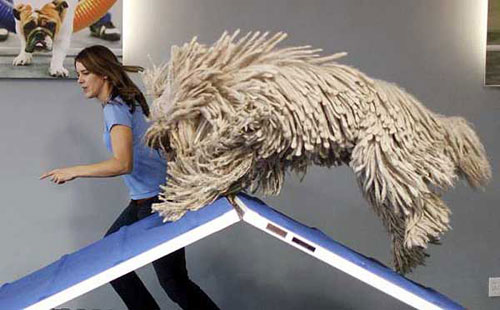
Clyde the Komondor @ the Zoom Room
When TMZ reported this week that Mark Zuckerberg was trying to decide between a Komondor and a Puli, we thought we needed to step in with some friendly advice.
As regular visitors to the Zoom Room – or to this website – know, our own pet dog is a Komondor: Clyde Orange, to be exact, the mascot of the Zoom Room.
Clyde, like all Komondorok (the plural of Komondor), is indeed quite the head turner. But when it comes to training one of these behemoths, he’s more like a head scratcher – as these are notoriously challenging dogs to train. (Not to mention grooming, another shaggy cross that all Komondor owners must bear.)
Pulik (the plural of Puli) might look quite like their Hungarian countrymen, the Komondorok, sharing the same distinctive dreadlocks known as “cords,” but they are altogether different in temperament.
So let’s take a quick look at each breed in the hope that we might help our favorite Facebook friend make an informed decision…
The Komondor
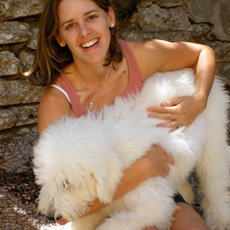
Clyde as a Puppy
To understand their temperament, it’s important to know that they have been bred since antiquity as livestock guard dogs. Picture one of these shaggy giants out wandering on a hillside with his flock of sheep, fairly well blending in, and not doing much of anything all day. A fairly cushy bank security guard gig in a sleepy town. So they conserve energy and tend to appear lethargic, as might a lizard on a sunny rock awaiting its meal.

Clyde in Beverly Hills Chihuahua 2
As a pet, a Komondor has many advantages: sweet, great with little kids, fun and goofy, infinitely cuddly, unflinchingly loyal.
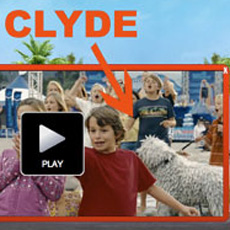
Clyde in Marmaduke
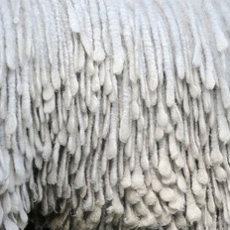
Clyde's cords. Photo courtesy AFP/Robyn Beck.
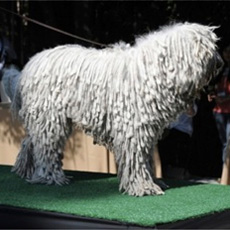
Clyde. Photo courtesy AFP/Robyn Beck.
You’ll need a pretty experienced trainer to work with a Komondor. (Mark Zuckerberg, if you’re reading this, the Zoom Room has locations right here in L.A.) But once he’s trained, it’s hard to deny the almost indescribable joys of sharing your home and your life with such a wonderfully silly and magnificent beast.
We’ve barely touched on grooming – as this is an almost limitless topic. Simply know that your neighborhood dog groomer will likely never have encountered one – and great care must be taken in finding the right groomer. Helping the cords form evenly, separating them from one another as the matting begins around the age of nine months, is an ongoing process for the next year or so. After that, the challenge shifts to drying. Washing and shampooing a mature Komondor isn’t all that complicated. But if many hours of diligent drying aren’t carefully completed, your damp dog will develop mildew. This is to be avoided at all costs.
Normally you never cut a Komondor’s cords, and you certainly never touch a Komondor with a brush. The cords will continue to grow and grow, once formed, until they eventually reach the ground.
The Puli
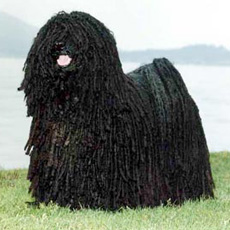
Courtesy of Westminster Kennel Club
Pulik also serve a completely different job: they are herding dogs. Their temperament is therefore much more like a Sheltie. They are quick and agile, and require plenty of daily exercise. A Komondor, on the other hand, can laze about for much of the day.
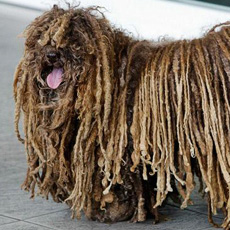
One of the many shades of grey Puli
The herding instinct is hard-wired; it isn’t something you teach your Puli. That said, if you do want to do some recreational herding, it’s best to practice starting at a young age. Puli can also be trained fairly easily in agility and obedience.
They share the exact same requirements for grooming as a Komondor, but of course since a Puli is tiny compared to a Komondor, the entire process – especially the drying – is vastly easier.
The other trait they share is loyalty and a penchant for protection. Pulik can also be stalwart watchmen, albeit without the sheer size and musculature of a Komondor.
Final Thoughts
Both breeds are infinitely lovable. And both will make it difficult for you to walk down the block without being stopped by countless curious passersby wanting to know what that creature is at the end of your leash – and is that his real hair – and did you braid it yourself – and you’ll soon find yourself answering a succession of questions while children gather round to hang on the cords. For celebrities, it might be a nice relief to find that your dog is being noticed and photographed more than you. For those reluctant to chat with strangers, these are not good breed choices!
The size difference alone can help make the decision between the breeds for most people. 16 inches and 30 pounds vs. 30+ inches and 100+ pounds isn’t even in the same ballpark.
A jet black Puli has the enviable advantage of hiding dirt when compared to the theoretically snow-white Komondor, whose cleanliness will always present an uphill battle.
As Komondor owners ourselves, we’re a bit biased, and can’t imagine life without our monster. Our one-year-old baby curls up in Clyde’s cords, and he truly completes – and protects – our family. And although he’s now a movie star and a certified Therapy Dog, he has kept his down-to-earth goofiness, and we couldn’t be more delighted.
But if unlike us you’re not professional dog trainers, think twice before inviting a Komondor to guard your threshold. Training them ain’t easy – believe us!


20 Comments
Richie Madden
Hello, great article. Question: Where did you get your Komondor? Breeder name? I am unable to find anything on that. Thanks!
Zoom Room
Hi Richie,
We just sent you a note – Clyde is from your neck of the woods back east!
– Your friends at the Zoom Room
carmen
hi, i’ve seen one of these type of dogs a couple of years ago in fremantle, perth, western australia. i was’gobsmacked’. what a magnificent looking dog with such an interesting nature! are there any breeders in australia? thru curiousty, i’d like to learn more.
cheers,
carmen
Michael Bosse
Great Article
I’m getting a baby Komondor Shortly (I’m in Chicago). When I tell people I’m getting a 2nd dog,
no one has any clue what a Komondor is
Donna Galvin
We have had two of these wonderful dogs and now my daughter is on her second. They are marvelous dogs – so goofy and lovable. They love to back up to a sofa or ottoman and just sit down. They also think that people are meant to lean on.
We kept their hair cut, however, because the cords were too difficult to keep clean.
Quito
We took delivery of a Puli puppy about 2 months ago and just love him to death. He has a TON of energy but has such a great personality. When he’s old enough, we’re looking forward to getting him into agility training. It doesn’t look like you have any offices in San Diego but if you have any recommendations on great agility trainers in the city, I’d be happy to look them up! Thanks!
Zoom Room
Hi Quito,
Good news! We DO have a location coming to San Diego – we announced it just last week, and you’ll now see it on our Locations page. Our San Diego Zoom Room will be opening in early Spring 2012.
We look forward to seeing you and your Puli soon!
– Your friends at the Zoom Room
heather whitley-quinn
hi-
we live in san diego and are looking for a komondor pup. any recommendations?
Louis
Had 2 Pulis growing up, they were the best dogs. We would take them backpacking and they loved the outdoors.
My parents did finally give in and we would cut their hair short because keeping them clean just became impossible.
Thanks for the article.
LaShawnda
Hi, I first saw a picture of this dog a couple of years ago, while considering getting a pooch. I live in NYC – think small apartments and irregular outside play and walking time. I’m intrigued by the dreads/cords and am wondering if the Komondor sheds. If so, is it a lot or minimal?
Zoom Room
No shedding!
Lesa
I have a 2 yr old black puli who is a real character! I found a groomer, thank goodness when we got him as a puppy that vowed to learn along the way and has kept him georgous! He goes every month or 2 and his cords are awesome. No one here in WV knows what he is, at times I wonder myself. He can be very bossy, and possessive with our other dog that we are working on with training. He always is on call, definately not a lazy dog. Great for someone who takes long and mulitlple walks or hikes, not good left inside all day or just outback in a fenced yard. Needs alot of stimulation. But sooo incredibly lovably and sweet with kids and me and my husband.
Dawn McNamara
Oh, I wish I lived near one of your locations! Unfortunately, I’m in northern Canada. Anyway, I have three pulik and have been thinking about getting a Komondor when we move onto acreage. We do agility and rally-o with the pulik. Can Koms do dog sports? I see the photo of Clyde on the aframe, so maybe it is possible? Also, do you have any info on your drying setup?
Bettina Curtis
Great article very informative
on the differences between both breeds.
I just love them both,they remind me of
Rastafarians when they are in movement.
Thanks again for the info.
Bettina Curtis
Aquagoddess
Salima
Can a puli &the komondor be mated? If so, do you know of any breeders? These dogs are adorable…this is coming from a woman who has always been afraid of dogs…but i am compromising w/the hubs & i get to choose what kind of dog we get…lol 😉
Ray
Any info on Puli owners in San Diego or Southern California? I would like to chat with an owner more to know more about owning one, such as barking tendencies (which I’ve read about) and any other challenges (unrelated to grooming). Also, when forming cords is this difficult to do well? Or is it just time and patience in setting the initial cords ? Any info on owners or from owners is appreciated.
Traci
Hi. I adopted my first dog, a poodle, a few years ago at a local pet store adoption day. I wanted a noon shedding breed. They had what I’m now assuming was a Puli. I fell in love, but thought he might be a little too much for me and my 2 kids. He was such a bruise, dragging me all through the store! We love our poodle, but I can’t help but wonder what ever happened to that Puli. Anyone in Orlando know?
Mike and michelle
Now that i’ve read your article it has shed a new light on the constant barking. we have dogs on both sides of our yard and regardless of the fact that she knows they are there, our lily has to let them know she is just next door! she will bark at our neighbours she has met on many occasions. my question is, will she over time and with constant reminding, ever slow down with the barking? Thank you for your support.
-C from Saratoga, Ca.
I had a Komondor as a child/teen/young adult. His name was Pandor Bear. Or Panda for short. He was everything you could want in a ranch dog. He spent the day traveling to the different pastures and paddocks watching our pigs, sheep, cattle, horses, aviary, flocks of free range geese, chicken, ducks, and our wild game sheds. He protected our small dogs and roving cats just as lovingly as he did the baby goats. He walked apace of wild predators like the mountain lions and bobcats- never attackinf when they came to the creeks for drinj. When the neighbors 5 german shepherds pack attacked our goat field and brooding hen barn- he attacked and killed all 5 of them with no damage to himself. Panda would bring the bull into the corral from the pastures during rut season and could just as easily walk into our rabbit barn and retrieve a runner without hurting it. We never needed to train Panda. A firm arm gesture and “get” “sit” “down” or “quiet” was enough. The rest he intuitively taught himself. Panda was not a dog that was mean, dumb, or lazy. He was however, independent. If we asked him to do something we learned the best way was to take him to a pasture, point and say “get” The rest he did on his own. This is the kind of dog that trains men in patience and kindness. He was always patient and kind to our diverse livestock.
Montana
Great article! Even some tidbits i didnt quite kniw before(but have experienced) about the breed! My female komondor is a mere 27″ and 90-95 lbs on he petitist end of the spectrum for the females, she’s barely larger than a labradoodle or german shepard! About twice as muscular though! She (Lulu) IS BRIBABLE WITH (fresh raw meats, cheese, whole chickens, blueberries, etc) food and has just as much love for fresh treats as i do myself, and barely touches her food if unadorned it will sit untill she is hungry and ready to eat which is once a day or so. Over all amazing dog that never over eats (unless you bribe so be very careful about monitoring calorie intake, they distribute their fat well so You’d never know they were fat till they are in the danger zone unless they are shaved!) , cuddles with me most nights (except when its hot then only for a few minutes a night or morning), firecely loyal though has no problem leaving my side if someone has some food she wants (though she always prefers/comes to treats from me if more than one person is offering!), they do pick up habbits from less welbehaved dogs and animals so becareful about that, very easy to learn a bad habbit compared to training it out.